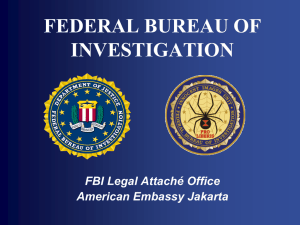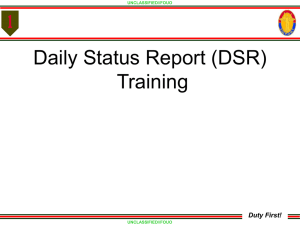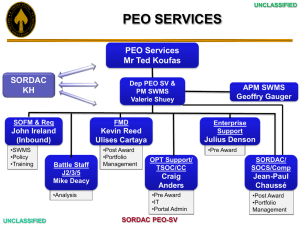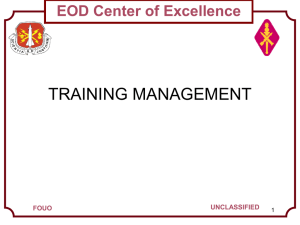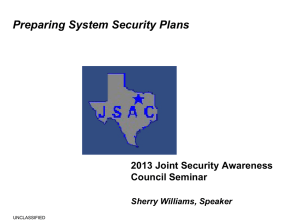05_CHIRPs
advertisement
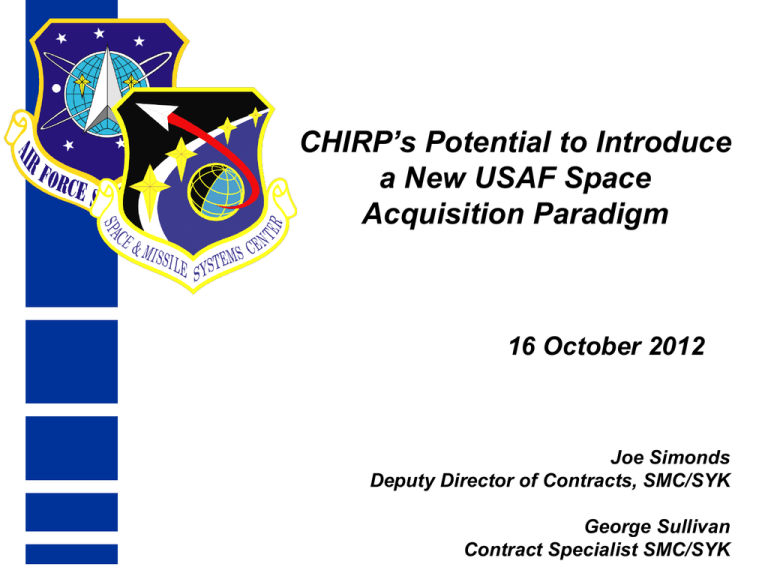
CHIRP’s Potential to Introduce a New USAF Space Acquisition Paradigm 16 October 2012 Joe Simonds Deputy Director of Contracts, SMC/SYK George Sullivan Contract Specialist SMC/SYK UNCLASSIFIED -- FOUO Background • The Alternative Infrared Satellite System (AIRSS) project began in 2006 at the Developmental Plans Directorate (XR) of the Space and Missile Systems Center (SMC). • In 2008, Americom Government Services (AGS) submitted an unsolicited proposal that led to CHIRP program stand-up. • Hosted Payload Office (HPO) formed in July 2011 to coordinate USAF Space Command hosted payload efforts. • CHIRP launches flawlessly in September 2011 and begins on-orbit ops. • Oct 2011 – CHIRP+ Acquisition planning begins • 28 Jan 2012 – PMD formalizing HPO approved by Lt. Gen. Ellen Pawlikowski. • March 2012 - HPO IDIQ Acq planning begins UNCLASSIFIED -- FOUO 2 UNCLASSIFIED -- FOUO Policies Supporting the Use of Hosted Payloads • The FY09 Defense Authorization Bill instructed the Secretary of Defense to assess “the manner in which commercial satellite capabilities are used by the Department of Defense and options for expanding such use or identifying new means to leverage commercial satellite capabilities, such as hosting payloads” • Report on Technology Horizons – A Vision for Air Force Science & Technology During 2010-2030: “Fractionated or distributed space systems can potentially provide greater onorbit capability at lower cost than is achievable with traditional approaches, while allowing rapid reconstitution in the event that elements in the constellation are lost.” • National Security Space Strategy – Unclassified Summary, Dept. of Defense and Director of National Intelligence, January 2011: “As we invest in next generation space capabilities and fill gaps in current capabilities, we will include resilience as a key criterion in evaluating alternative architectures. Resilience can be achieved in a variety of ways, to include… hosting payloads on a mix of platforms in various orbits.” UNCLASSIFIED -- FOUO 3 UNCLASSIFIED -- FOUO USAF Evolving Approach to handle the 3 Cs • The Three Cs: • Congested – physical and radiofrequency spectrum • Contested – advances in adversarial counterspace capabilities • Competitive – lower barriers to entry and increasing access to advanced technologies at lower cost • New architecture terminology: Resilient and robust. Architectures must be able to withstand steadily growing threat of accidental and intentional interference (resilience) while maintaining or enhancing capabilities provided to the warfighter (robust) • Exploring disaggregated architectures – USAF moving away from “Battlestar Gallactica” approach to examine possibilities for disaggregated architectures involving, inter alia, hosted payloads. UNCLASSIFIED -- FOUO 4 UNCLASSIFIED -- FOUO CHIRP Project Date Event Dec 05 USecD Krieg calls for new competitor for SBIRS Apr 06-Apr 08 XR develops requirements and hardware for this competitor, renamed 3rd Generation Infrared Surveillance (3GIRS) Jan 08 AGS submits an unsolicited proposal to SMC for CHIRP rideshare using upgraded one-eye sensor from SAIC-RR payload Jun 08 SMC contracts with AGS for CHIRP, with a payload delivery in Jul 09 and an expected launch in May 10 Jul 09-Dec 09 Due to delays in the payload development, the payload delivery is pushed back – first to Oct 09, then Dec 09, and finally May 10 Feb 10 Launch is delayed until 3rd quarter 2011 - $18.5M ECP required Sep 2011 CHIRP launches and is operating on-orbit as expected CHIRP was committed to an aggressive schedule but suffered delays resulting mainly from the sensor upgrade and, to a lesser extent, integration and launch issues. Nevertheless, the sensor has been operating on-orbit as expected and was launched far more quickly than traditional military free-fliers. UNCLASSIFIED -- FOUO 5 UNCLASSIFIED -- FOUO CHIRP Mission Objectives 1. Collect real-world IR data commensurate with 3GIRS performance • Collect against cooperative targets and targets of opportunity • Assess performance of WFOV sensor against a wide variety of weather and seasonal conditions 2. Investigate spacecraft-sensor interactions and sensor behavior in space environment • Jitter, line-of-sight motion, thruster firings, out-gassing, EMI, contamination, thermal interactions, etc. • Natural space environment effects over mission life 3. Explore operational issues relevant to 3GIRS • Algorithm performance on real-world data • Effect of the communication link on overall performance 4. Evaluate long-term suitability of a commercial host • Mass, power, thermal, schedule, command and data link constraints unique to the “ride” opportunity UNCLASSIFIED -- FOUO 6 UNCLASSIFIED -- FOUO Commercially Hosted IR Payload (CHIRP) On-Orbit Testing of WFOV Data & CONOPs Payload • SAIC sensor from payload contract • ¼ earth, 1-eye field of view • No on-board processing • Tactical cryocoolers • SWIR, MWIR, SWIR/MWIR STG • Min. 1 year design life • NSA hardware encryption • Class D mission • MW/MD/BA/TI/C&E Mission areas SES World Skies USG Solutions Commercial Launch • Ariane V • GEO at 87º W Longitude • 21 Sep 2011 • Dual spacecraft launch Cost $82.5M* / FFP (Awarded 27 Jun 08) *Includes launch and operations Spacecraft Bus • Enhanced STAR 2.4 Bus • Standardized secondary payload interface • Dedicated payload thermal radiator • Commercial C2 ground • Mission data downlink via dedicated transponders On-Orbit/Ground Processing • 1+ month initialization & checkout • View over CONUS test ranges • Transmit at 70Mbps to ground • Mission Analysis Center for end-to-end processing • DoD data archive and exploitation Teleport Control Center UNCLASSIFIED -- FOUO 7 UNCLASSIFIED -- FOUO CHIRP Lessons Learned - Contracting 1. Finish up-front systems engineering and development before contracting for launch 2. Keep it simple and avoid multi-tier subcontracts and overlapping contracts a) Reduces pass-through costs b) Reduces potential for communication problems 3. Have one Govt team responsible for payload development and hosting 4. Despite problems and ECP – total costs and schedule ended up being a small fraction of those for a typical free-flier Pre-integration and test CHIRP Contractual Structure UNCLASSIFIED -- FOUO 8 UNCLASSIFIED -- FOUO CHIRP Lessons Learned - Technical Problem Potential Fix Getting attitude, time, or other information between the unsecured system of the vehicle and the secured system of the payload requires a manual step and thus impacts payload mission data utility 1) Hard to calibrate the sensor and monitor FPA degradation while the payload is in orbit because it affixed to the vehicle. Problem more a challenge to OPIR sensors and remote sensing platforms 1) Needed to make undesirable modifications to payload so that it will not interfere with vehicle E.g., payload baffle shortened to make room for the vehicle’s antennae; cryocooler was designed with insufficient knowledge of the heat dissipation plan for the space vehicle Insist on receiving vehicle’s specs early on in the process to address interference between the payload and vehicle in the design phase Generic “do no harm” principle insists that the needs of the vehicle always trump the requirements of the payload – even at the cost of the mission E.g., the commercial host may need to move the satellite so that the satellite cannot view friendly targets Possible contractual clauses to protect Government interests and provide liquidated damages for certain eventualities; but otherwise, this may be an unavoidable risk of commercial rideshares 2) 2) Add on-board infrastructure so the vehicle can securely transfer information to payload Add components to payload so that it can be selfsufficient (star trackers, GPS, etc.) Add on-board calibration equipment, albeit at a cost of additional weight Have the ability to nod into deep space (and store data during the process) Problems currently being addressed real-time and novel solutions being employed. UNCLASSIFIED -- FOUO 9 UNCLASSIFIED -- FOUO Challenges with Commercially Hosted Payloads Government vs. Commercial schedules • A contractor cannot delay the launch without risking a loss of satellite coverage. • The Air Force does not want to deliver the payload for integration until it has been fully tested. • Loss of launch opportunity could kill a program – very high schedule risk • CHIRP benefited from confluence of fortunate circumstances regarding delays in both Govt and commercial schedules • Contractors’ launch schedules, orbits and payload activation plans not always best for Government’s purposes, but variances can be negotiated UNCLASSIFIED -- FOUO 10 UNCLASSIFIED -- FOUO R&D Advantages of Hosted Payloads TECHNOLOGY READINESS LEVELS TRL 1 2 3 4 5 6 7 8 9 Basic principles observed and reported. Technology concept and/or application formulated. Analytical and experimental critical function and/or characteristic proof of concept. Component and/or breadboard validation in laboratory environment. Component and/or breadboard validation in relevant environment. System/subsystem model or prototype demonstration in a relevant environment. System prototype demonstration in an operational environment. Actual system completed and qualified through test and demonstration. Actual system proven through successful mission operations. Source: DOD Deskbook 5000.2-R AP1.1 UNCLASSIFIED -- FOUO - Air Force will not fully rely on technology until it passes through all TRLs. - New space tech often stalls at level 6, since the next step requires a demonstration in the operational environment. - The high failure rate between TRL 6 and 7, earned that step the moniker of the “valley of death.” - Hosted payloads provide a cheap and efficient way for an R&D prototype to traverse the “valley of death.” Note: Colors are not DOD standard 11 UNCLASSIFIED -- FOUO Life After CHIRP • CHIRP a great success despite speed bumps and technical limitations • Projected benefits of hosted payloads validated • Cost savings apparent: • CHIRP R&D costs (including development, program office costs, calibration, testing, integration, launch, and ground infrastructure for C2 and MDP) = $216M • Operational legacy free-flier costs (build and launch) = ~$1B • Technological advantages: • OPIR payload development to launch: 3-5 years • Legacy free-flier development to launch: 10-15 years • Legacy system is already a proven technology, is operational, certified and providing a critical national capability, but TRLs for HP technologies are rising and potential for operational use being proven • Cost-cutting and rising threats driving increased focus of DoD and Congress on disaggregation, possibly signaling a paradigm shift to prioritizing acquisition of small, less-expensive assets over large, complex assets UNCLASSIFIED -- FOUO 12 UNCLASSIFIED -- FOUO Establishment of Hosted Payload Office (HPO) • The HPO PMD signed by Lt. Gen Pawlikowski on 28 Jan 2012 tasks the HPO with: • Coordinating with SMC directorates for detailed implementation of hosted payload options • Performing concept and architecture development and risk reduction • Coordinate the design, development, procurement, test, launch, and operations of government payloads within operational architectures on commercial and/or government hosts. • Hosted payload = an instrument or package of equipment affixed to a host spacecraft, which operates in orbit making use of available capabilities of the host spacecraft, including mass, power, and/or communications. (Futron Guidebook definition) • Industry engaged via SMC/HPA forum in September 2011, Satellite 2012 Conference in March 2012 and HPA summits in DC in October 2011 and September 2012 UNCLASSIFIED -- FOUO 13 UNCLASSIFIED -- FOUO HPO – Longer-term Big Picture • Standing up an IDIQ (HoPS – Hosted Payload Services) for procuring launch, integration and ops for developed payloads: • Need money and Congressionally-approved requirements from SMC directorates • Other SMC directorates expressing interest: • Already engaged with Infrared Systems, MilSatCom, Space Weather and Space Superiority Directorates • GPS has indicated some interest • NASA is very interested and an IPT participant UNCLASSIFIED -- FOUO 14 UNCLASSIFIED -- FOUO HoPS Status and Current Contract Structure • Market research underway: • • • Contracting/business workshop with HPA members held in July 2012 Sources sought synopsis issued September 17, 2012; responses received October 1, 2012 Industry One-on-Ones held October 2 and 3, 2012 • Draft RFP planned for November and Industry Day for December • ASP currently being drafted • Contract Structure • • • Multiple-award IDIQ Ceiling estimated at value of 5-6 delivery orders Planning to request approval to consider this as supplies, not services • • • • Supplies being delivery on-orbit and useable data delivered Will have to rename contract (originally thought of as services) 5-year PoP as a “trial run” FAR 12/FFP delivery orders preferred UNCLASSIFIED -- FOUO 15 UNCLASSIFIED -- FOUO CHIRP+ • Key part of Infrared Systems Directorate’s Overhead Persistent Infrared (OPIR) Space Modernization Initiative investment effort • Purchase of 9 degree OPIR staring sensor to be launched as a hosted payload • Class C sensor with 3-5 year design life optimized for battlespace awareness mission • High TRL heritage hardware to be used • 36 month development schedule after ATP • Intended to advance TRL of OPIR Wide Field of View (WFOV) technology UNCLASSIFIED -- FOUO 16 UNCLASSIFIED -- FOUO OPIR Mission Areas • Missile Warning • • Missile Defense • • Provide reliable, accurate, and timely IR target signature and threat performance data to warfighters, the intelligence community, weapon system developers, and other users Battlespace Characterization/Awareness • • Provide reliable, accurate, and timely information to defensive systems Technical Intelligence • • Reliable, unambiguous, timely, and accurate missile warning information to the President of the United States, the Secretary of Defense, Unified Commanders, and other users Provide reliable, accurate, and timely data to enhance situational awareness, nonballistic missile threat warning, decision support, battle damage assessment and intelligence information (for land, sea, air, and space) for unified commanders, Joint Task Force (JTF) Commanders, and other users Civil/Environmental Uses • Provide support to national, state, local, foreign, and civil and environment agencies for natural and man-made disasters and events (e.g., cloud cover, ash clouds, snow and ice accumulation, electrical grid blackouts, forest fires, floods) UNCLASSIFIED -- FOUO 17 UNCLASSIFIED -- FOUO Challenges to DoD Use of Hosted Payloads • Money and Politics • Lack of funds committed to stand up new HP projects • Funds still tied up in legacy programs • Substantial effort by SMC and AFSPC required to refocus funding priorities despite already having HQ, AFSPC and SMC leadership support • Culture • Acquisition process requires streamlining to capitalize on commercial opportunities • Inversion of requirements definition approach: Focus first on how to field something inexpensive with a few key capabilities versus something large with myriad capabilities UNCLASSIFIED -- FOUO 18 UNCLASSIFIED -- FOUO Conclusion • CHIRP is only the beginning, and a successful one at that • Many invaluable lessons learned from CHIRP can be applied on CHIRP+ • HPO stand-up and PMD approval a clear sign of leadership support and commitment to pursuing HP opportunities • CHIRP success and increasing DoD and NASA support signal potential for acquisition paradigm shift • Challenges remain, many of which can be surmounted by a groundswell of support from industry, Congress and DoD for the use of hosted payloads in disaggregated architectures and for rapid TRL advancement UNCLASSIFIED -- FOUO 19
